The Skaftafell Ice Cave in Vatnajokull National Park in Iceland is a spectacular tunnel formation that can only be seen during the winter when temperatures are low enough for the glacial rivers to freeze; thus, the caves reform in different locations with new paths to explore each year.

You have to be flexible if you want to catch this sight, as the tour is highly dependent on conditions. But it’s worth it. Being inside an Ice Cave provides visitors with the unparalleled opportunity tow capture blue light passing through glacier ice.
Experience the Ice Age in Eisriesenwelt
The Eisriesenwelt Ice Cave in Werfen, Austria is one of the most majestic caves you'll ever set your eyes on. Extending 42 kilometers into the earth, this limestone ice cave is the largest of its kind, it's no wonder it welcomes 200,000 tourists every year. The oldest layer of ice in the cave walls dates back as far as 1,000 years! Though this cave is huge, only the first kilometer of it is frozen and open to tourists. The rest of the cave consists mainly of limestone.

The ice formations were created from melted snow water that drained into the cave and froze. The structures remain icy even in the summer because the cave entrance is always open, leaving it exposed to the cold wind that keeps the temperature below freezing. In fact, new ice formations appear each spring, but as the water drips into the cave it freezes.
Wavy Rock Formations
Cueva de Arpea in Spanish, or Caverne d'harpea in French, however, you chose to call it you can't help but admire this intriguing natural formation. The cave system was formed under the twisted layers of rock in the Aezkoa valley on the Franco-Spanish border and is believed to have been used as a refuge by ancient shepherds since old times.

These unique formations and surrounding greenery are a must-see for adventure seekers and cave enthusiasts.
You'll Think it's Photoshopped
The Antelope Canyon of Arizona formed out of the erosion of sandstone from rainwater and flash flooding, is truly awe-inspiring and if you don't see it for yourself you'll be fooled that it's photoshopped . The Antelope Canyon includes two different, but equally amazing slot canyon sections referred to as "Upper Antelope Canyon" and "Lower Antelope Canyon" or "The Crack" and "The Corkscrew" respectively.

Both are in the LeChee Chapter of the native Navajo Nation. The canyons aren't open to the public and are accessible by guided tours only.
The Blue Gym of Capri
This Blue Grotto is a sea cave located off the coast of the island of Capri, in southern Italy. As its name implies, it's famous for its brilliant shades of blue. As sunlight, passes through the huge underwater cavity, shining through the water, it creates a beautiful turquoise reflection that illuminates the cave. So it's not surprising that it attracts millions of visitors from the area and from around the globe alike.

Hopefully you know how to float if you get visit this treasure island, as you'll need to lie on your back in order to cross through the cave's opening, which is no more than a meter tall.
Ancient life in a Strange Cave
Scientists have discovered a new range in Naica, Mexico in which life itself can subsist. Unlike the habitats of many other caves and subterranean areas, where bacterial colonies grow on mossy walls and soil with little or no sunlight at all, scientists discovered that the microbes in Naica have been embedded within giant crystals. By and large, what they found here were single-celled bacteria.

They estimate that life has been flourishing here, in these strange conditions, for around 50,000 years. What’s more, this form of bacteria feeds itself by digesting minerals like iron and magnesium, which are abundant within the crystal formations. Now, the scientists have moved their focus to figure out just how life is able to thrive in such an extreme habitat.
Not Your Average Cavern
Another famous sea cave on our list. but not less impressive is the Fingal's Cave in Staffa, Scotland. It's very distinctive cubic structure is formed from hexagonal basalt pillars that formed together. in a Paleocene lava flow. What's even more interesting about this cave it that its size, shape, and naturally-arched roof combine with the waves to make mystic sounds that enhance its already cathedral-like atmosphere.

The origin of the Cave's name surrounds around Finn MacCumhaill, or Fingal (250 AD) - a Celtic parallel to King Arthur. The legend say that Fingal was the father of Ossian, the traditional bard of the Gaels. When Gaels migrated from Ireland into Scotland the stories of Fingal came across too, thus he soon became revered in Scotland as well.
The Cave of the Shrine
The Batu Caves in Malaysia is home to one of the most popular Tamil shrines outside of India. It was built in honor of Lord Murugan (a Tamil God), which makes it also a focal point of Hindu festivals.

The Batu Caves have been used by both English and Chinese settlers, and the indigenous Temuan people. This historic cave is filled with statues and is always open for visitors.
The Spectacular Shades of Blue
The Blue Lake Cave, in Brazil is famous its eerie natural formations, but even more so for it's mesmerizing deep cerulean lake. While there are other lakes in the surrounding areas this natural colored lake is the most impressive on by far.
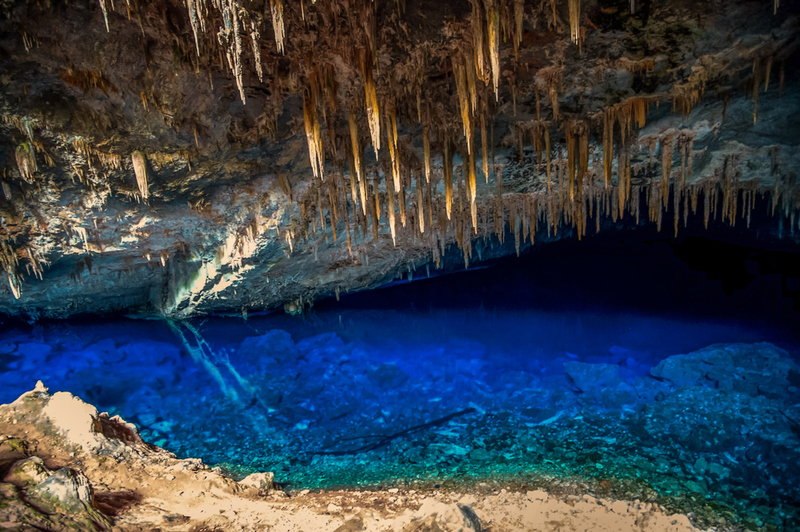
The stunning underground blue body of water plunges to a depth of 200 ft. Some believe that this lake is fed by an underground river that has yet to be discovered.
Marvel at St. Michael's Cave
St. Michael’s Cave in Gibraltar dates back thousands of years. This cave seems to posses a magical allure that can’t keep visitors away, as its exquisite formations, massive chambers, and rich history attract over 1,000,000 visitors a year.

In the early 1800's, two soldiers went down to explore this vast cave, but mysteriously vanish within its limestone halls, with their remains never to be found.
Worms That Glow in the Dark
The tides of certain oceans are crowded with phosphorescent bacteria that glow near the surface, mesmerizing all who are lucky enough to bear witness. They look almost like stars, glimmering in the night sky, except they are right there in the water around you, clear, close and able to be interacted with. Similar phosphorescent bacteria can be found in deep sea fish, where they are put to work, like those that inhabit the bulb of an angler fish. In New Zealand, a similar phenomenon can be found lining the ceilings and walls of caves.

If you take a kayaking trip through this cave in Waitomo, New Zealand, you will likely encounter this natural magic; and don’t be surprised if these luminous little objects move! The sweet little things that inhabit this cave system, believed to have been formed some 30 million years ago, are actually worms. They dangle casually from the ceiling, waiting for their next meal.
Bat Country
There’s a cave in Barangay Tambo, on Samal Island, that is only 245 feet deep. Unremarkable at first glance, once inside the cave you will be stunned to discover that even Dracula or Batman would quiver at the sight of the thousands of bats it houses.

This cave in Samal Island is being utilized as a sanctuary to the Monfort bat. They have been multiplying numerously for years in the subterranean shadows, where their sense of echolocation allows them to know precisely how much space they have and the distance the structure extends. They hang onto cave walls in such vast abundance, it appears, at first glance, that the cave has been painted black.
Caves of Ancient Death
If you’re into adventure movies of the Indiana Jones variety, or have ever wondered if the prehistoric tribal stories of human sacrifice are true, a cave located in Northern Ireland will certainly pique your interest. It holds relics suggestive of human sacrifice that have been preserved up to this day.

Locked in its dark chambers are human bones, creepy sights of human heads on pikes, and other rarities. A rather common sight, as you traverse the cave’s winding ways, are pits full of discarded human remains. Charming. These caves are part of the larger Smoo Cave, and getting there requires the full suite of adventuring and spelunking skills. The terrain is hard to navigate and, human sacrifices aside, may not be for everyone.
The Aquatic Salamander
Scientists say the creatures that thrive underground are much harder to distinguish from each other compared to those that live on the surface. With less variety in their conditions, the distinctions they have evolved aren’t as sharp. They tend to be unusually shaped, and their features develop according to the extreme conditions of subterranean environment, so the deeper a cave goes, the weirder they get.

The aquatic salamander is one weird creature that lives in the caves of Slovenia and Croatia. It is blind, breeds and swims underwater, a palish pink critter. It uses its electro-sensation to master its environment, and it can live for more than a hundred years.
See Art of Ancient Settlers
Niah Cave is one of the largest limestone caves in the world, and is of major historical significant as it hold the drawings dating as back as 40,000 years ago. Archaeologists and historians believe that its inhabitants were among the earliest settlers in eastern Malaysia.

The caves are also a popular tourist destination the birds' nest industry, as all the birds that roost in the caves are privately owned and the owner has the right to collect the nests. Collection is usually done in January and in June.
Caves Filled With Poison
While they may be dark and alien to us surface-dwellers, caves can be inviting. Some are even made tourist attractions by governments, with a range of activities designed to appeal to professional spelunkers and day-trippers alike. But don’t count Movile Cave in. If you dare to enter this cave, located in Constanta, it could quite possibly be the last site you ever visit in your life, with all the danger it poses.

As folklore would have it, vampires, ghosts, and ghouls aren’t the only things to fear in Romania. Constanta, which is located near the Black Sea, has many “poisonous caves,” named for the deadly creatures that crawl through their depths. Centipedes, spiders, scorpions: Movile Cave has them all. Traversing its narrow limestone tunnels will eventually lead you to a cavernous opening in which you will find a lake. If you’re picturing the kind of pristine waterways we humans love to relax by on the surface, think again. Movile’s lake gives off the rotten egg smell of sulfur, and the atmosphere in its amphitheater is thick with a variety of gases. Disturbing the tranquility of its surface with a skipped rock would cause it to emit poisonous hydrogen sulfide. So maybe leave it off your list of lakes to visit!
Caves Filled With Poison: Part II
Movile isn’t the only poisonous cave Constanta has to offer. In fact, it is home to many such caves that are extremely dangerous and require careful planning and safety equipment to explore. Some scientists, of course, are willing to try their luck. One of the most intense caves they’ve uncovered requires climbers to drop down into its depths where the oxygen level of the atmosphere is reduced by half.

Once the descent has been made, wading through its poisonous waters adds an extra layer of danger to its already hostile environment. Being fitted with a breathing apparatus is essential. Otherwise, adventurers would quickly develop a headache, become hypoxic, and die on the spot. This cave is home to numerous species that scientists are dying to study.
Caves Filled With Poison: Part III
The stories that emerge from these poisonous caves are astonishing but few and far between. If scientists were able to examine the caves more regularly (and safely) they’d certainly be able to come up with scientific reports that read more like works of science fiction. One line of inquiry they’re currently working on is how bacteria are able to subsist in ecology that offers no oxygen at all.

To adapt, they have developed a way to break down the chemicals in the air. They function similarly to plants in taking in carbon dioxide. Some bacteria break down sulfur into sulfur oxide. Strangely enough, this increasing presence of sulfuric acid eats out the surrounding limestone, allowing the cave to expand its size even further.
See Rare Formations in Lechuguilla Cave
Lechuguilla Cave, located in New Mexico is by far the most special cave in the world. Interestingly, up until 1986, it was considered a rather small and insignificant cave; however, recent exploration proved it to be otherwise, as the discovery of its massive chambers along with some of the rarest formations ever seen.

At 138.3 miles (222.6 km) is actually the longest limestone cavern in the United States. Lechuguilla is named for the canyon it goes through, which is named after Agave lechuguilla, which is a species of plant found there. Access to the cave is limited due to scientific research constantly taking place there.
The Spider from Baja
If you cringe upon the sight of a large house spider, the Baja spider might just be too much for your mind to take in. Unlike the common spiders, we are accustomed to seeing (that still make us leap in fear), the Baja spider is just as deadly as it looks.

But they can’t be found just anywhere, so there’s no need to fear them… unless you plan on exploring the caves up in the Sierra Cacachila mountain ranges. Baja spiders like to spy on their prey, waiting for the right time to pounce and take them out. They lurk in the darkness of the cave walls. Their dark color perfect for melting, unseen, into the shadows. Despite their mammoth four-inch diameter (the average length of a smartphone), these little devils are practically invisible. The Baja spider is closely related to the Brazilian wandering spider, a.k.a. the most poisonous spider in the world.
Dark Blue Holes
Many people entertain the false belief that, to have a shot at cave exploration, they would first have to climb mountains or trek through forests and ranges. This couldn’t be farther from the truth. Some caves require diving into the ocean, too.

There are many underwater caves all over the world, but the Bahamas has the highest number of them. Like caves found on dry land, underwater caves are defined by their dark orifices. The darker its shade, the deeper it plunges. The substrata of the caves trap the incoming light, causing the waters to appear a darker shade of blue. It is a sight to behold from above, especially now, in the day and age of drones.
The Largest Cave in the World
The Sơn Đoòng Cave in Vietnam is the largest known cave in the world to date by volume. This massive cavern is full of countless wonders including its own weather systems, ecosystems, and geological formations. It's believed to be around 2-5 million years old.
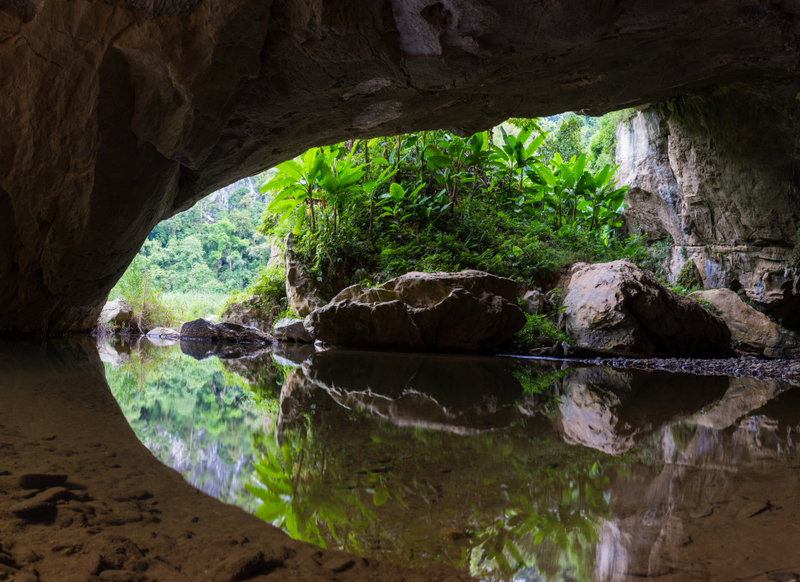
Sơn Đoòng means 'cave of the mountain river' in Vietnamese, after its internal, fast-flowing underground river.
An Endless Hole
Some rocks weather in time, causing them to break and leave voids and treacherous crevices, extending down into the depths of the Earth. While this sounds ominous, it is most likely how many of today’s caves were born. Some of the results of this process, though, are truly terrifying. This bottomless pit in Ellison’s Cave is something else. It is not bottomless, per se. But if you plan on throwing a rock and waiting for it to reach the bottom, you might want to consider setting up camp.
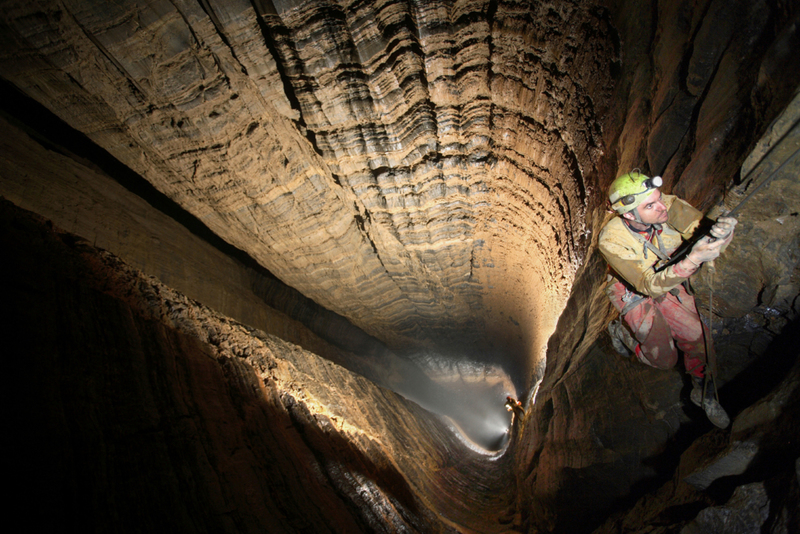
Ellison’s Cave (which extends vertically for 1063 feet) is actually dotted with more than one pit. The big daddy of them all, suitably named “Fantastic,” is estimated to stretch down 586 feet. That’s about half the height of the Empire State Building, around 51 stories. The hole is deep dark space, filled with meandering offshoots and alien-like subterranean creatures, making it a perilous spelunking site. Ellison’s is the 12th deepest cave in North America, but the Fantastic pit takes the top prize as the deepest unobstructed pit on the continent.
Hidden Lakes
Greece is known for its rich history, beautiful scenery, and high ridges with white plastered houses lined atop. While many think most of the food when planning their Greek getaways, caving is also a popular reason to travel there. Some of Greece’s caves are nestled on the country’s pristine mountaintops, whereas others are to be found submerged beneath the crystalline blue waters of its coastline. With both representing a stunning adventure, your next trip to Greece might just have to involve a mix of both.

The Melissani is a cave one can climb up to and, once inside, spelunk down to find a limpid, peaceful lake running through it. It is named after the island it’s located on, and tourists love to go there to explore the place via kayak or canoe. It’s an adventurer’s hidden paradise.
Stalactites - A Natural Wonder
Stalactites are among the very first things that catch your attention whenever stepping inside a cave. They feel like long needles, reaching down from the cave’s ceiling, ready to thrust into you at any minute. They are also beautiful to look at, majestic, like the natural pillars of an ancient, subterranean kingdom.

These natural wonders are gradually formed by sediment-heavy water dripping from the ceiling of the cave. As you might expect from something formed by slow drips, they aren’t the quickest of growers. It can take up to 1,000 years for a stalactite to grow just four inches (the length of a smartphone… or a Baja spider!). Speleothems are the most common type of stalactite in the world, due to the abundance of limestone in caves. The longest stalactites on Earth can be found in Jeita Grotto in Lebanon, measuring up to 27 feet in length.
Cave Art
Caves make us feel as though there is always something exciting lurking in their depths. Filled as they are with dark, craggy corridors, our sense of adventure tells us there simply must be at least a thing or two for us to discover within. While they are a place of mystery and exploration for modern humans, back in prehistoric times people lived in caves. For early humanoids, caves were a rare and welcome shelter against hostile external conditions. So, finding relics and links to this long-forgotten past isn’t far-fetched at all.

In fact, in this Argentinean cave, explorers have discovered dozens of hand-prints lining the rugged walls. These have been interpreted as an early form of art, with red chalk used as a medium. The work is said to be 9,500 to 13,000 years old, and this discovery tells us as much about prehistoric man’s nature as it does about modern man. It seems that, through the millennia, we have always been possessed by an inherent need to express ourselves creatively.
Stalagmites - The Other Natural Wonder
Stalagmites owe their existence to their twins from above: the stalactites. Their growth occurs gradually, from the ground up, built from the mineral-rich droppings off the stalactites on the ceiling. Stalactites and stalagmites are on a quest to meet each other from the moment the first drip drops. Over the passage of time and the layering of minerals, they move by infinitesimal fractions towards their twin.

Like stalactites, it takes many years for a stalagmite to develop. The longest stalagmite in existence can be found in the Doolin Cave in Claire, Ireland. It is said to project from the ground at around 21 feet high, which is about the length of George Washington’s nose... on Mount Rushmore that is.
Marvel at the Marble
Mother Nature surely outdone herself when she created the Marble Cave in Patagonia, Chile. This stunning natural Marble formation formed over 6,000 years from the waves of the Lake General Carrera that constantly washed against the solid stone.

The colors are absolutely natural as well, the various hues of blue occurred as a result of the lake’s azure waters, that indented patterns based on water levels at the time. There are three main marble formations: El Catedral (the Cathedral), La Capilla (the Chapel), and La Cueva (the Cave).
Scrolls from the Dead Sea
It’s important to be open-minded when discovering a new cave. They are known to hold many secrets, some accumulated through time, others evolving within it. You are as likely to find relics from past civilizations as you are some never-before-seen subterranean creature.

In this cave located in the Judean desert, explorers were shocked to discover more than they ever anticipated. More than secret lakes and rare minerals, this cave was home, in 1947, to the discovery of evidence of the coveted Dead Sea Scrolls. They were disheartened to find, too, that the scrolls themselves had been looted many years earlier. But other artifacts and scrolls remained. One of the manuscripts, written on papyrus and animal skin, contained texts dating back to the 4th century BC and the 2nd Century AD.
The Seasonal Treasure
The Skaftafell Ice Cave in Vatnajokull National Park in Iceland is a spectacular tunnel formation that can only be seen during the winter when temperatures are low enough for the glacial rivers to freeze; thus, the caves reform in different locations with new paths to explore each year.

You have to be flexible if you want to catch this sight, as the tour is highly dependent on conditions. But it's worth it. Being inside an Ice Cave provides visitors with the unparalleled opportunity tow capture blue light passing through glacier ice.
Neanderthals and Their World
A cave in France gives us a glimpse into the prehistoric world of the Neanderthals. In it, were found structures assembled by these archaic humans who lived for a bracket of time scientists estimate to span between 400,000 and 40,000 years ago.
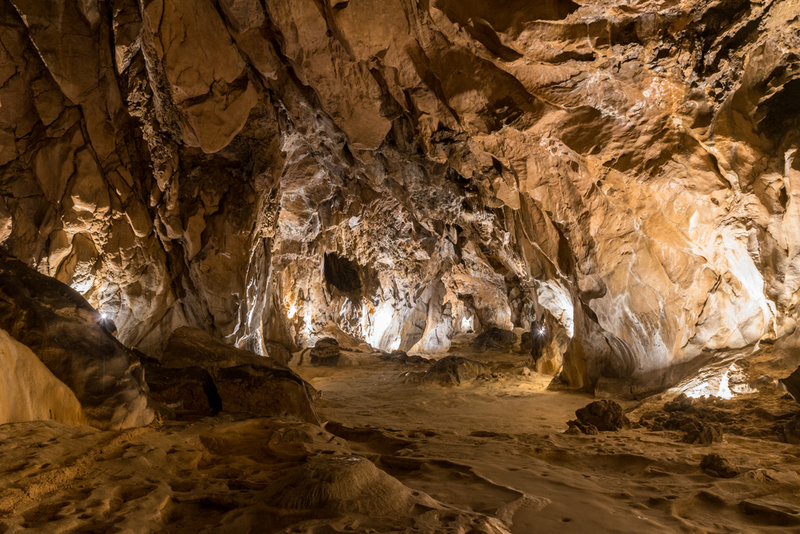
These structures are composed of both stalactites and stalagmites that have been cut down to form a sort of a pyre, or room-sized ring. Some have been made to form effigy chambers, and other structures for seances or similar rituals. There are other assemblages in this cave that baffle scientists and explorers up to this day as to their purpose, but offer valuable clues regarding the culture of our ancient predecessors.
Walk through the Longest Cave in the World
Mammoth Cave National Park, located in Kentucky, is the longest cave system in the world. It spans for more than 400 miles (640 km) with astonishing passageways, measuring twice as long as the second longest cave system- Sac Actun in Mexico's, which is an underwater cave.

The National Park offers fascinating tours, that informs visitors about numerous notable features of the cave, such as the Frozen Niagara, Grand Avenue, and the famous Fat Man's Misery. There's so much to see in this caves that tours tours can last up to six hours.
The Homes of Hobbits
A cave in Indonesia called the Liang Bua is able to offer solid proof that our planet was once home to humanoids that stood a stumpy 1m (3 ft 7 in). They are called Homo floresiencis, a name derived from that of the Indonesian island where they were found: Flores. The dominant consensus is that they are a distinct species from modern humans, as supported by genetic findings and their obvious anatomical differences.

The initial belief was that Homo floresiencis existed until 12,000 years ago, but this was superseded by new discoveries that indicate they actually ceased to exist some 50,000 years before the rise of the Neanderthals.
The Light at the End of the Tunnel
Near Benigal Beach, Portugal, this cave a literally a sight to sea (get it?). The entrance is covered in fine sand with a "rooftop" window where the sun rays beam in. The rich, warm colors of the formations and the sounds of the waves make this cave an alluring and welcoming sanctuary.

While it isn't advised to swim around to the cave to get as tides change quickly, and currents in this area can be very strong, but don't worry, there are plenty of boats around you can hop on. This cave is truly a natural wonder and all visitors will leave it inspired.
Cannibalism in Ancient Societies
Researchers have been trying to flesh out more details about how the Neanderthals lived thousands of years ago. Over the years we have been able to unearth some vital clues as to their appearances, as well as odds and ends about their culture. Then a Spanish cave delivered some shocking new developments. Evidence found within suggest the practice of cannibalism may have been rife among Neanderthals.

Are you ready to be creeped out? In this cave, human bones were found with bite marks in them. They are estimated to be around 10,000 years old, and have clearly been cooked and chewed on. What actually happened here is for our imagination to fill in. But studies suggest the Neanderthals likely did this as a tactic to intimidate rival tribes, rather than for nourishment.
Aquatic Lemurs
The ancient creatures that once roamed the Earth were gargantuan, even in comparison to the largest of the creatures we share the planet with today. So much so that there even used to be giant dragonflies buzzing across virgin forests, colossal birds and deer that stood more than ten-feet tall.

Lemurs probably aren’t the first creatures to come to mind when you think about large animals. But divers have uncovered lemur bones in an underwater cave in Madagascar, which startled them because of their enormous size. These mammals are arboreal, meaning they normally live in trees. How their bones came to rest in this deep, underwater cave is a mystery. For now, the most likely explanation is that they were washed away by the currents. Though the idea of giant, swimming lemurs migrating via the ocean is pretty cool (if far-fetched).
A Very Ancient Human Race
Just when scientists think they’ve got a handle on the human race and where we fit in the scheme of things, life leads them to little discoveries that throw everything back up in the air again. Our knowledge base is continually challenged and disrupted by our discoveries, with no better example than that of this confusing cave in Africa. Within its murky depths, scientists discovered a unique heap of human bones. Nothing like it had ever been found before.

These remains didn’t correspond to any data we have of the development of humans throughout ancient history, and scientists named it Homo naledi. Not enough data has been gathered yet regarding the exact age of this species, but it is currently estimated to be around 3 million years old. This hominid has a smaller brain cavity than that of modern humans, with a more pronounced brow ridge.
The Rainbow Cave
This remarkable cave in China appears to have been made out of particles from a rainbow. It is called the Karst Cave, and it is said to have been whittled by an ancient river that flowed through it 500,000 years ago.

What makes the Karst so beautiful inside is that the composition of its rocks, stalactites and pillars, reflect a blend of yellow, blue, and purple. It is also known as the Reed Flute Cave. Back in the war, due its accessibility, the Chinese once used this cave as a hideout, specifically against air raids. Not only is it beautiful, but it has saved countless lives, too.
A Different Kind of Pearl
One can only imagine the myriad of wonders to be found in this deep, mysterious cave. The stalactites and the stalagmites themselves capture our attention, taking the form of altars inside. We are at awe by the knowledge of how they are formed out of soluble material and its dripping for many many years until they are hardened, even crystallized.

Caves are capable of coming up with their own version of pearls, too. They may not be as valuable as those from the South Sea, but they are smooth and wonderful to witness. They are formed by the dripping of calcite-heavy water onto dirt, which in time solidifies into a collection of smooth spheres.
Explore the Ecosystems of Puerto Princesa
The Puerto Princesa Subterranean River National Park in the Philippines is a UNESCO World Heritage Site, and one of the New Seven Wonders of Nature. And if you're a nature lover, you'll be happy to discover all of the unique creatures, plants and all the biodiversity the cave has to offer, more than 800 plant species, including 300 species of trees, 200 bird species, 30 mammals, 19 reptiles and 8 bat species call the cave home.
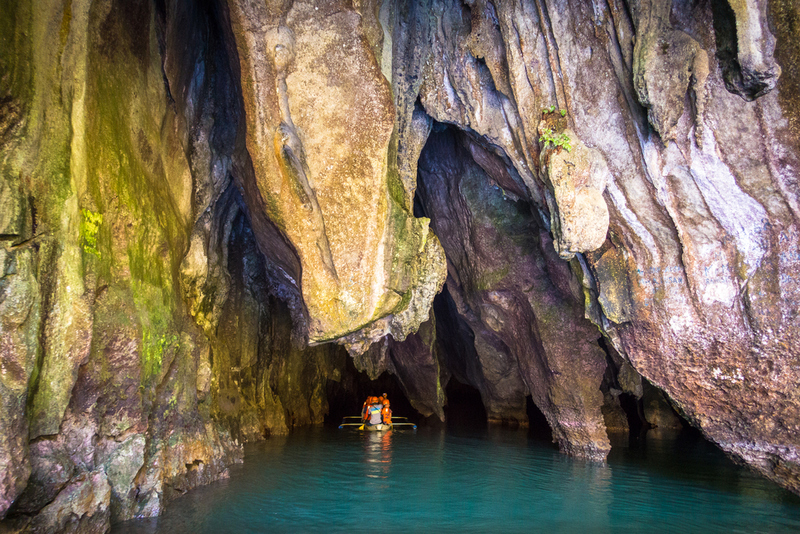
The entrance to the cave is only a short hike away from a nearby town, but the river, which is navigable by boat, is only accessible for up to 4 kilometers, because the critical lack of oxygen passed that point. If that wasn't cool enough, in 2010, a group of geologists discovered that the underground river has a second floor, which creates several small waterfalls inside the cave.
Mysterious Depths: Part II
Plunging into the depths of a cave where atmospheric changes are drastic will undoubtedly take its toll on even the most experienced explorers and researchers. Conquering the full depth of the Krubera Cave will take a huge amount of time, if they ever come out successful. They will have to move from one campsite to another, wade through uncharted territory and murky waters of unknown composition.

The main challenge is to adapt to an environment in which we aren’t designed to live in. The milieu itself can be disorienting. Then, on top of that, imagine all the gear that needs to be lugged around to sustain the explorers for as long as needed, dragged through small tunnels into the deep unknown.
Surround Yourself With Ice
This icy sanctuary near the Mutnovsky Volcano in Russia is a fascinating cave system formed in the glaciers surrounding area by fumaroles, which are small vents that release gases and volcanic heat. The volcano's last eruption occurred in 2000.

If you happen to visit the cave at the right time you'll witness the sunlight penetrating the frozen cave walls, painting them in all colors of the rainbow.
Fish With a Secret Messaging System
One of the most remarkable things about nature’s creations is their ability to adapt to all types of environment, even the most harsh and hostile subterranean territory where sunlight is ever-absent. Furthermore, many creatures have learned to subsist even without oxygen, thriving in areas poisonous to all other forms of life.

Some anatomical changes develop in these creatures so they don’t become extinct. Bats are able to use their echolocation to navigate in complete darkness. As part of the evolution process, this blind fish has developed what scientists call its lateral line, through which it is able to find its way around, sensing vibrations and pressure changes in the water. It is able to interpret subtle shifts in the environment via messages sent from this lateral line to its central nervous system, allowing it to act quickly, without the need for sight.
Massive Crystals
Any person without the proper protective gear would not last more than thirty minutes inside the Cave of Crystals in Naica, Mexico. The atmosphere within its expanse is around 118 degrees Fahrenheit, with a 90% humidity, so the temperature would drop even the hardiest of humans in a snap. We’ve shown you earlier how researchers remain perplexed at the persistence of life within the crystals themselves, which are estimated to be around 50 million years old.

These crystals have the appearance of huge, luminous bars that have been struck into the land. Some are around 36 feet long, weighing about 55 tons. Once you step inside the cave, these crystals tower over you, and they are formidable, to say the least.
The Bottomless Underwater Cave
The mesmerizing underwater cave of Chinhoyi Caves in Zimbabwe has been attracting explorers ever since its discovery in 1888. Deep water divers have explored as deep as 120 meters, but no one has reached the bottom to date, so luckily there's still lots to be discovered.

The cave system is composed primarily of limestone and dolomite. In the main cave you can find a pool of cobalt blue water, which is known as the Sleeping Pool or Chirorodziva ("Pool of the Fallen"). Scuba Diving is possible in the caves all year round, and the conditions are optimal as visibility is high and temperatures never rise beyond the 72 to 75 °F (22 to 24 °C) range.
The Curious, Wondrous Mystery of Caves
Despite the dangers involved in exploring the world’s most mysterious caves, scientists are endlessly drawn to devoting their time and effort to learning from them. Far more than just voids beneath the Earth’s crust, caves are rich hosts to a variety of relics and life forms. Beyond their dark openings lurk an array of vivid colors, an entirely new environment, a complex ecosystem waiting for us to discover its secrets.

Imagine what we might be able to do if all this information was to be unlocked? Within these strange environments, and among the creatures capable of inhabiting them, may lie the answers to pressing problems, like climate change and the processing of pollution. The possibilities are as broad as the caves themselves are deep. Moving forward, it is a journey that will be, at the very least, informative, dangerous, and full of life.
Explore the Depths of Majlis al Jinn
Majils al Jinn is tucked away in a remote area of the Selma Plateau in Oman. It is the second-largest cave chamber in the world, proving a challenge for adventure seekers, as you have to hike to the entrance of the cave and get lowered in by rope. As you get lowered into the depths of the cavern, you’ll get a true appreciation for it's beauty.

Up until 2008, Majlis al Jinn was a popular BASE jumping site, and several events and special promotions were hosted there until the Oman government placed declared it off limits.
Feast Your Eyes in This Salty Wonder
Recently an Israeli-led research team explored the Malham Cave in the Negev region of Israel, just southwest of the Dead Sea. Measuring more than 6 miles (10 km) in length, it's well ahead of Iran's Namakdan which measures 4 miles (6 km), and now holds the record as the world's longest salt cave. As it's mapping is still incomplete, it's likely that they'll add a few hundred meters as they reach the tightest areas of the cave.
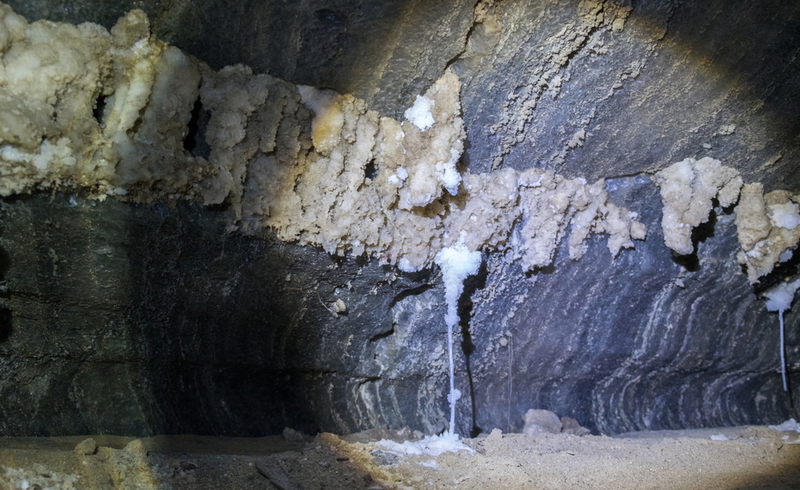
Like its name implies, its walls of this "salt cave" are made out of the same type of sodium-chloride that's in the shaker on your kitchen table. Radiocarbon dating revealed that the cave is around 7,000 years old. It was reported that one of the team members added some of the salt to his pasta. Quite resourceful if we must say.